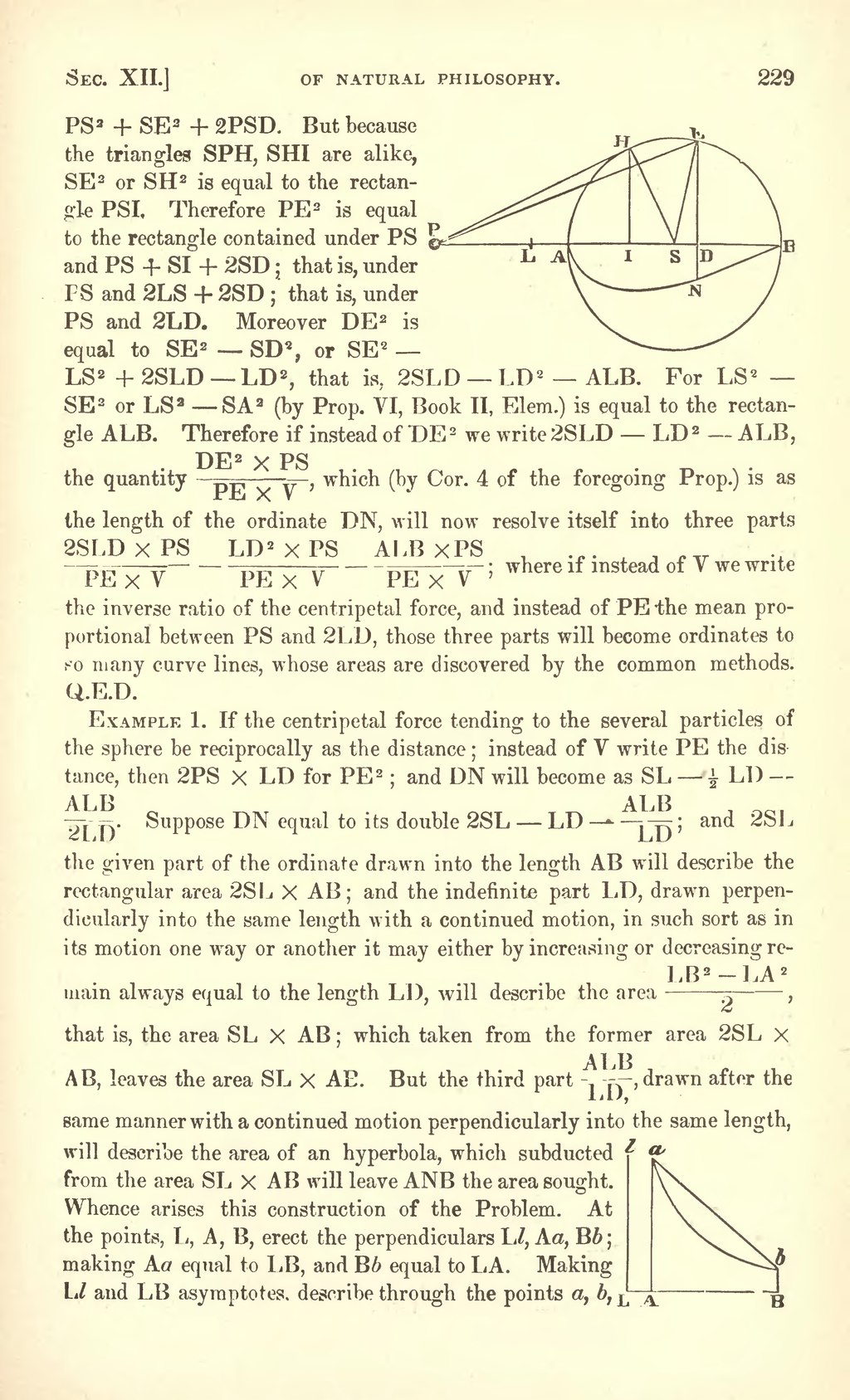 PS² + SE² + 2PSD. But because the triangles SPH, SHI are alike, SE² or SH² is equal to the rectangle PSI. Therefore PE² is equal to the rectangle contained under PS and PS + SI + 2SD; that is, under PS and 2LS + 2SD; that is, under PS and 2LD. Moreover DE² is equal to SE² - SD², or SE² - LS² + 2SLD - LD², that is, 2SLD - LD² - ALB. For LS² - SE² or LS² - SA² (by Prop. VI, Book II, Elem.) is equal to the rectangle ALB. Therefore if instead of DE² we write 2SLD - LD² - ALB, the quantity , which (by Cor. 4 of the foregoing Prop.) is as the length of the ordinate DN, will now resolve itself into three parts ; where if instead of V we write the inverse ratio of the centripetal force, and instead of PE the mean proportional between PS and 2LD, those three parts will become ordinates to so many curve lines, whose areas are discovered by the common methods. Q.E.D.
PS² + SE² + 2PSD. But because the triangles SPH, SHI are alike, SE² or SH² is equal to the rectangle PSI. Therefore PE² is equal to the rectangle contained under PS and PS + SI + 2SD; that is, under PS and 2LS + 2SD; that is, under PS and 2LD. Moreover DE² is equal to SE² - SD², or SE² - LS² + 2SLD - LD², that is, 2SLD - LD² - ALB. For LS² - SE² or LS² - SA² (by Prop. VI, Book II, Elem.) is equal to the rectangle ALB. Therefore if instead of DE² we write 2SLD - LD² - ALB, the quantity , which (by Cor. 4 of the foregoing Prop.) is as the length of the ordinate DN, will now resolve itself into three parts ; where if instead of V we write the inverse ratio of the centripetal force, and instead of PE the mean proportional between PS and 2LD, those three parts will become ordinates to so many curve lines, whose areas are discovered by the common methods. Q.E.D.
Example 1. If the centripetal force tending to the several particles of the sphere be reciprocally as the distance; instead of V write PE the distance, then 2PS LD for PE²; and DN will become as SL - ½LD - . Suppose DN equal to its double 2SL - LD - ; and 2SL the given part of the ordinate drawn into the length AB will describe the rectangular area 2SL AB; and the indefinite part LD, drawn perpendicularly into the same length with a continued motion, in such sort as in its motion one way or another it may either by increasing or decreasing remain always equal to the length LD, will describe the area , that is, the area SL AB; which taken from the former area 2SL AB, leaves the area SL AB. But the third part , drawn after the same manner with a continued motion perpendicularly into the same length,  will describe the area of an hyperbola, which subducted from the area SL AB will leave ANB the area sought. Whence arises this construction of the Problem. At the points, L, A, B, erect the perpendiculars Ll, Aa, Bb; making Aa equal to LB, and Bb equal to LA. Making Ll and LB asymptotes, describe through the points a, b,
will describe the area of an hyperbola, which subducted from the area SL AB will leave ANB the area sought. Whence arises this construction of the Problem. At the points, L, A, B, erect the perpendiculars Ll, Aa, Bb; making Aa equal to LB, and Bb equal to LA. Making Ll and LB asymptotes, describe through the points a, b,






